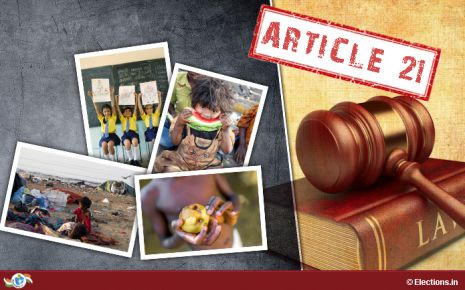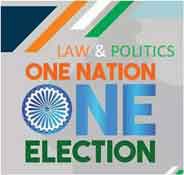Article 368: Amendment Of The Indian Constitution
Article 368: The Amendment Of The Indian Constitution
A constitution is a document with specific legal sanctity that establishes the framework and primary functions of a state's organs of government (the Executive, the Legislature, and the Judiciary) and defines the principles regulating the activities of those organs.The constitution is acknowledged as the mother of all laws in India. While teaching criminal law, one of my professors stated that if an advocate cannot find a remedy to an unfamiliar problem under the IPC, CrPC, or any other procedural laws, he or she must resort to the Indian Constitution!
That is how significant, vast, and comprehensive our constitution is. So, can such a supreme law of the land be amended? The answer is absolutely yes, but with some restrictions. The basic structure is an aspect of the constitution that cannot be changed. In the upcoming sections, we will go through the basic structure doctrine in detail.
The Rationale Behind Article 368:
The constitution's framers avoided making it overly restrictive because too much rigidity and the inability to change a constitution might stifle a state's growth and progress. For the welfare of society as a whole, changing times necessitate changing laws, and a newer society necessitates newer laws. However, the founders were also aware of the potential repercussions of making the Constitution overly adaptable to change. The government will alter it anytime it wishes, according to their whims and fancies. As a result, both extremes were avoided, and a middle ground was chosen.Types of Amendment:
It is now clear that the Constitution's provisions can be changed. However, the question of what articles are amendable and how they are amendable may arise. Article 368, clause 2 specifies two categories of articles that can be modified using proposed methods. They are:
- Amendment by special majority; and
- Amendment by special majority and its ratification by states.
NOTE: Certain provisions of the Constitution can be modified by parliament with a simple majority vote. Simple majority approval is required for the amendment process envisioned under Article 4 (changes to 1st and 4th schedules that deals with names of Indian states and number of Rajya Sabha seats respectively), Article 169 (Abolition or Creation of legislative councils in Indian states), and 239-A (Creation of local Legislatures or Council of Ministers or both for certain Union territories). These articles are expressly excluded from the scope of the process outlined in Article 368.
- Amendment by special majority:
This category includes all constitutional amendments other than those indicated above and those listed in the next category. A special majority is described as a majority of the entire membership of each house of parliament, as well as a majority of not less than two-thirds of the members present and voting in that house.
- Amendment by special majority and its ratification by states:
Articles requiring a special majority as well as ratification by at least half of the state legislatures fall into this category, according to article 368. The following provisions require ratification by states:
- Articles 54 and 55, which deal with the presidential election.
- Articles 73, 162, 241, or 279A, which deal with the union's and states' executive powers.
- Articles 245 to 255, which establishes the balance of legislative authority between the federal government and the states.
- Articles dealing with the judiciary, including the Supreme Court, state high courts, and UTs.
- Amendments to the Seventh Schedule Lists. (Union, States, and Concurrent lists)
- A change in the representation of states in the parliament.
- Article 368 itself
Therefore, it is evident that the majority of the articles of the Constitution may be amended through the usual legislative procedure. Only a few provisions dealing with the federal idea need a special majority and states ratification.
A Chain Of Constitutional Law Cases That Led to The Emergence Of The Basic Structure Doctrine:
As stated at the outset, certain basic features of the Constitution cannot be changed. Those core provisions, if altered, may change the very essence of the purpose of the Constitution. Article 368(3) specifies that nothing in Article 13 applies to any alteration made in conformity with this article. This means, Article 13 does not fall under the purview of Article 368. Article 13 stipulates that laws that are inconsistent with fundamental rights are null and invalid.
In Shankari Prasad v. Union of India [i], the subject of whether basic rights can be altered under Article 368 was challenged for the first time. The Supreme Court ruled that the ability to amend the constitution under Article 368 encompassed the power to amend fundamental rights as well, and that a constitutional amendment is legitimate even if it violates fundamental rights.
A similar judicial argument was raised in a subsequent judgement in Sajjan Singh v. State of Rajasthan [ii]. In this case, the validity of the 17th constitutional amendment (1964) was challenged. The Supreme Court had once again upheld the decision given in Shankari Prasad's case.
Golak Nath v. State Of Punjab [iii] is the cornerstone decision for the formation of the Basic structure doctrine. The constitutionality of the 1964 Amendment was once again called into question.
What's the deal with the 17th Amendment to the Constitution? Through this amendment, certain state statutes were incorporated into the 9th schedule. Why is the 9th schedule so peculiar and powerful? The ninth schedule was inserted into the Indian constitution via the first constitutional amendment in 1951, with the primary goal of abolishing the Zamindari system.
The superpower of this schedule is that any provision (even if it breaches fundamental rights) inserted within it is immune from judicial scrutiny. As a result, the parliament is afforded unrestricted authority to shield any arbitrarily enacted legislation under the canopy of the 9th schedule, which is exactly what happened.
As a consequence, it was put to the test. The Supreme Court, by a 6:5 majority, prospectively overruled the Shankari Prasad and Sajjan Singh cases ruling, holding that parliament had no competence to change Part 3 of the Constitution and to take away fundamental rights since the date of this judgement.
Despite the fact that this decision elevated the stature of the judiciary to a higher tier, the choice of 'prospective' overruling was a setback.
The parliament was obviously unhappy with the verdict and enacted the Constitution (24th Amendment) Act in 1971. This legislation amended Article 13 and restored and expanded the parliamentary power to amend the Constitution.
The legality of this act was challenged in the case of Keshvananda Bharati v. State of Kerala [iv]. During the pendency of the case, the petitioner's challenged Kerala Land Act was moved to the 9th schedule by the 29th CAA. The argument was what was the extent of the amending power provided by article 368? To hear the case, an exceptional and the largest bench of 13 judges was formed!
The court reversed Golaknath's verdict by a majority, ruling that the 24th constitutional amendment was declarative in character and lawful. Having said that, the Supreme Court also opined that, under Article 368, the legislature's power to amend the Constitution is wide but not unlimited and is not permitted to change the basic framework of the Constitution.
What Comes Under The Purview Of The Basic Framework?
As a result, the mighty Keshvananda Bharati case gave rise to the notion of basic structure doctrine and specified which provisions fall under its jurisdiction. Similarly, when this theory was applied to subsequent judgements, further provisions were added to the list. Let's understand them in sequence.
Through Keshvananda Bharati verdict:
- Supremacy of the Constitution
- Republican and democratic forms of government
- Federal character of the constitution
- Separation of powers between the legislature, the executive, and the judiciary
- Dignity of the individual secured by various freedoms and fundamental rights
- Parliamentary democracy
- National unity
Through the Indira Nehru Gandhi's case:
In the famous Indira Nehru Gandhi v. Raj Narain[v] case, the Supreme Court struck down clause 4 of Article 329A, which was added by the 39th Constitutional Amendment Act in 1975. This was accomplished through the use of the basic structure doctrine. During the verdict process, the following features were added to the already existing list of basic framework.
- Judicial review,
- Democracy (free and fair elections),
- Rule of law, and
- Supreme Court jurisdiction under Article 32.
In Minerva Mills Ltd v. Union of India[vi], the Supreme Court knocked down section 55 of the 42nd CAA, which had inserted clauses 4 and 5 to article 368 on the grounds that they violated the basic framework, and added the following features
- Independence of judiciary,
- Parliament's limited power to amend the Constitution,
- Harmony and balance between fundamental rights and DPSP's.
Through the Ninth Schedule case:
In I.R. Coelho v. State of Tamil Nadu[vii], popularly known as the 9th Schedule case, the Supreme Court unanimously held that any statute that damages the basic structure, even if it is incorporated in the 9th Schedule, is open to judicial review.
A quick and brief flowchart.
Conclusion:
The Indian constitution has been changed 105 times till date, proving the continued and consistent execution of Article 368. As said in the beginning, changing times necessitate changing laws. The Indian court has proven its worth by standing firm against any piece of legislation that breached a basic tenet of the constitution. Our constitution's defining quality, as opined by Dr. B.R. Ambedkar, is its flexibility, which is amazingly accurate!
End-Notes:
- [i] AIR 1973 SC 1461
- [ii] AIR 1965 SC 845
- [iii] AIR 1967 SC 1643
- [iv] AIR 1973 SC 1461
- [v] AIR 1975 SC 2299
- [vi] AIR 1980 SC 1789
- [vii] AIR 2007 SC 861
Law Article in India
Legal Question & Answers
Lawyers in India - Search By City
LawArticles
How To File For Mutual Divorce In Delhi

How To File For Mutual Divorce In Delhi Mutual Consent Divorce is the Simplest Way to Obtain a D...
Increased Age For Girls Marriage

It is hoped that the Prohibition of Child Marriage (Amendment) Bill, 2021, which intends to inc...
Facade of Social Media

One may very easily get absorbed in the lives of others as one scrolls through a Facebook news ...
Section 482 CrPc - Quashing Of FIR: Guid...

The Inherent power under Section 482 in The Code Of Criminal Procedure, 1973 (37th Chapter of t...
The Uniform Civil Code (UCC) in India: A...

The Uniform Civil Code (UCC) is a concept that proposes the unification of personal laws across...
Role Of Artificial Intelligence In Legal...

Artificial intelligence (AI) is revolutionizing various sectors of the economy, and the legal i...








Please Drop Your Comments